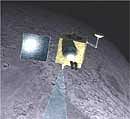
After confirming the presence of water on the lunar surface, India's Chandrayaan-1 mission has, for the first time, discovered mini-magnetosphere that would throw light on the "inventory" of Hydrogen on the moon, a top space scientist said on Friday.
SARA (Sub-keV Atom Reflecting Analyser), an instrument on board the country's first lunar orbiter, has made the discovery, Dr Anil Bhardwaj, the Principal Investigator for SARA, said. The present concept on the inventory of Hydrogen on the moon would change now, he said, while addressing the platinum jubilee meeting of the Indian Academy Sciences here.
"The amount of inventory of Hydrogen on the lunar surface would be much different than we thought earlier. It would be lesser (than previously thought)," he said. Bhardwaj, Head, Planetary Science Branch at ISRO's Space Physics Laboratory, Vikram Sarabhai Space Centre (VSSC) in Thiruvananthapuram, said there was a "theoretical conjecture" that probably the small magnetic field can form mini-magentosphere on moon.
SARA's findings are "first confirmation that prove that mini-magnetosphere can exist with such small magnetic field". "This is the first step towards the confirmation of a theoretical suggestion that mini-magnetosphere can be produced," he said.
SARA was built jointly by scientific groups from Sweden, India, Japan and Switzerland. Bhardwaj said the findings on mini-magnetosphere are under submission and would be published in scientific journal shortly. SARA has also for the first time detected ion fluxes on the "night side" of Moon. "Moon is a huge source of energetic neutral hydrogen atoms. 15-20 per cent of the impinging solar wind protons (on the lunar surface) are reflected back as neutrals," Bhardwaj said. "The amount of hydrogen which is being implanted on the lunar surface is reduced (as one out of every five protons incoming from the solar wind rebounds from the moon's surface). You have less amount of hydrogen getting absorbed on the lunar surface," he said.